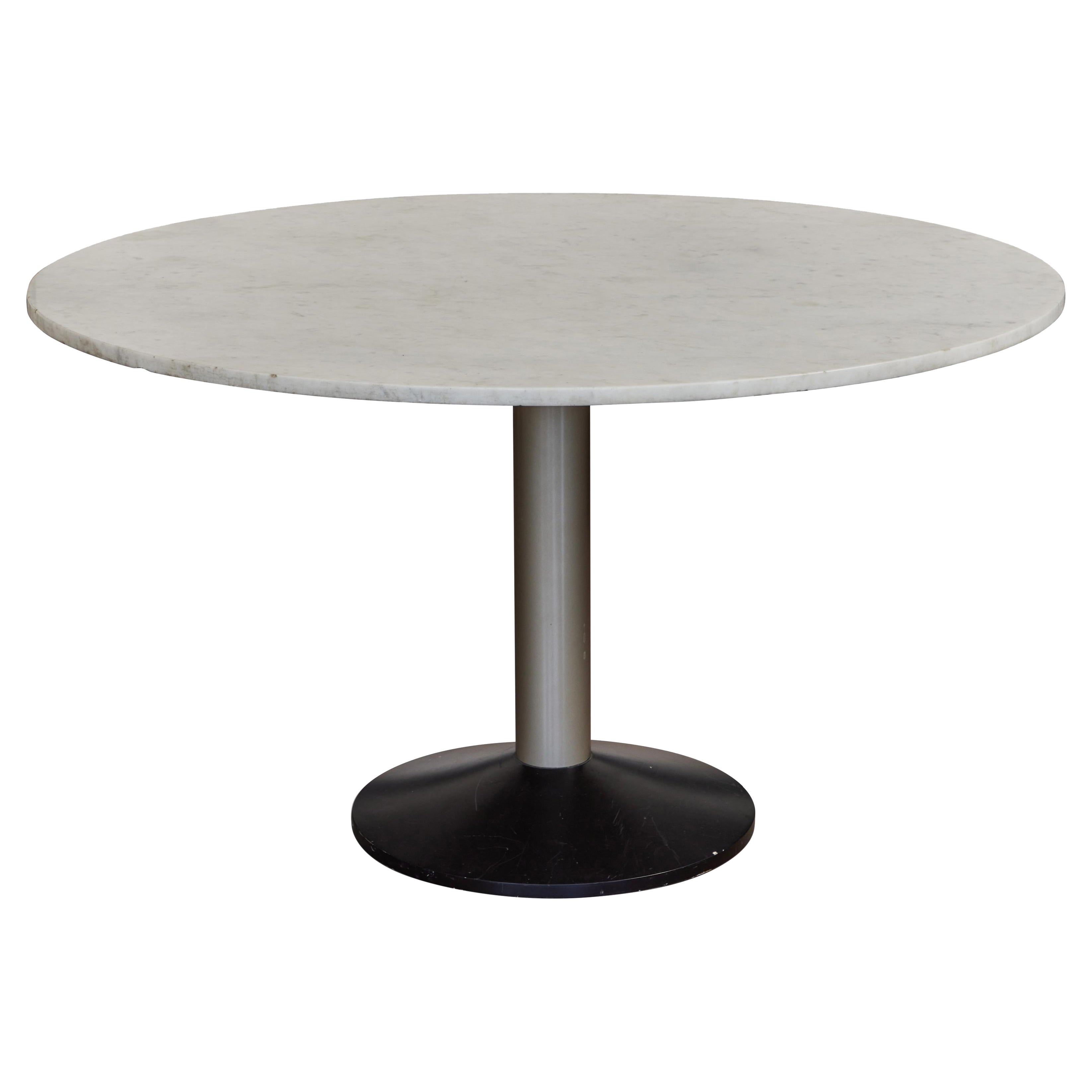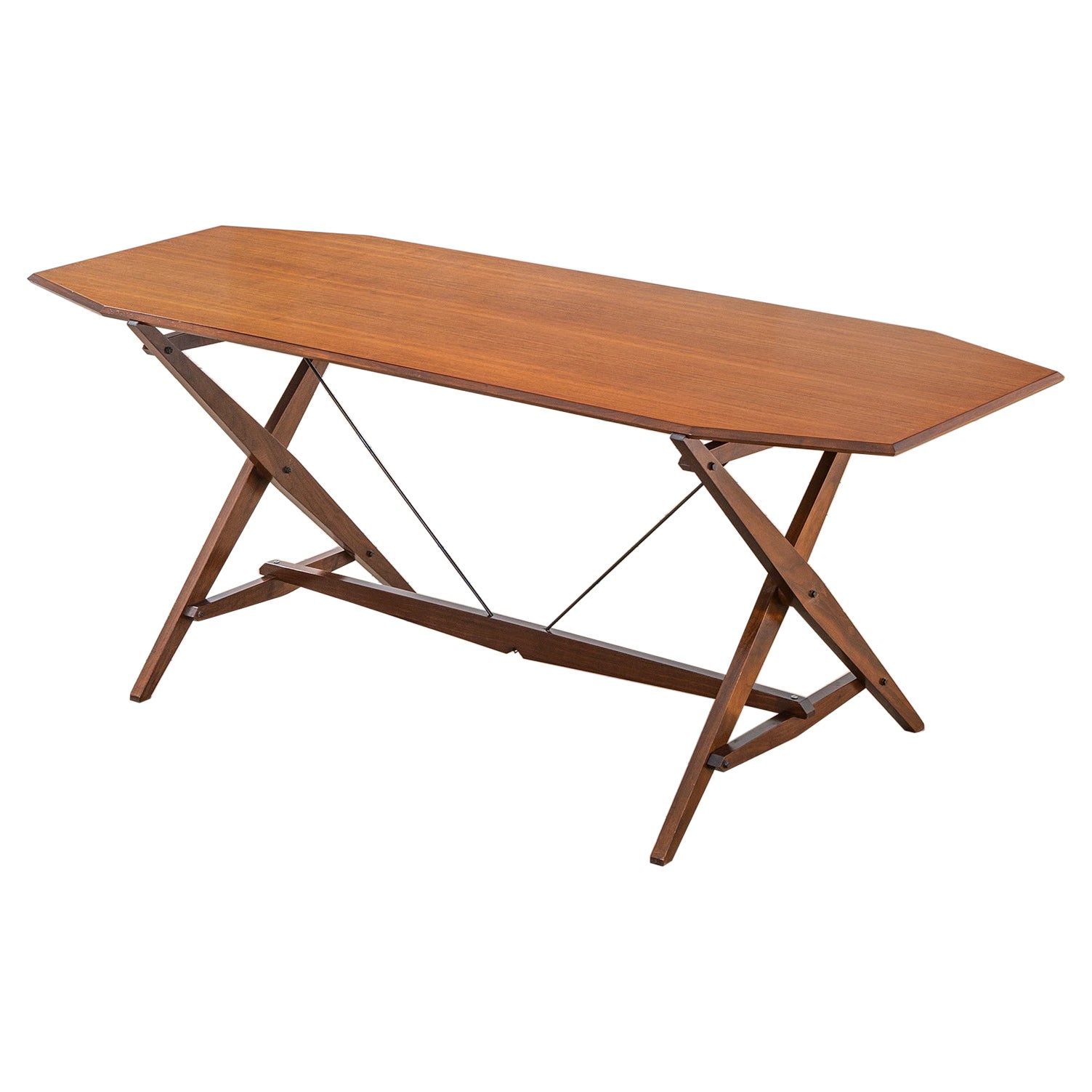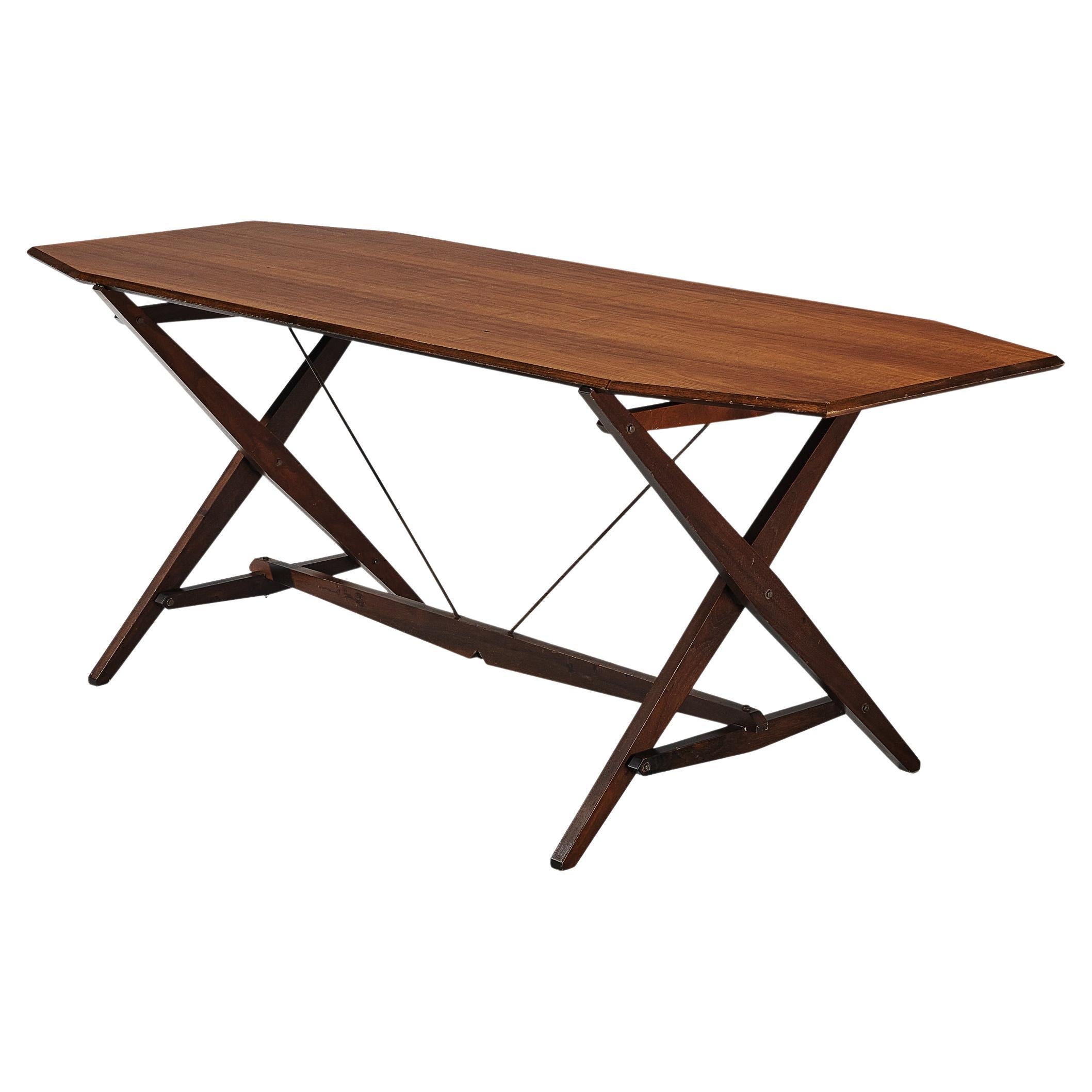Franco Albini TL30 Round Table in Metal and Wood for Poggi Pavia 1950s Italy
About the Item
- Creator:Franco Albini (Designer),Poggi (Manufacturer)
- Dimensions:Height: 29.14 in (74 cm)Diameter: 49.22 in (125 cm)
- Style:Mid-Century Modern (Of the Period)
- Materials and Techniques:Metal,Wood,Lacquered
- Place of Origin:Italy
- Period:1950-1959
- Date of Manufacture:1950s
- Condition:Wear consistent with age and use.
- Seller Location:Montecatini Terme, IT
- Reference Number:1stDibs: LU5304221190982
Franco Albini
While working under the polymath Gio Ponti — arguably the most important figure in 20th-century Italian modernism — furniture designer Franco Albini nurtured a love for modern forms combined with traditional craft techniques.
Albini is widely known for working with organic materials such as rattan and cane for his chairs and other seating, but he also played a pivotal role in the Italian rationalist movement of the early 20th century, which saw architects and furniture makers applying a strict emphasis on geometry in their work. Rationalists drew on Ancient Roman architecture but rejected ornament, much in the way that Le Corbusier and celebrated Bauhaus figures such as Ludwig Mies van der Rohe had in their modernist furniture.
Albini received his degree in architecture from the Polytechnic University of Milan in 1929, and, in 1931, he founded his practice in Milan, where he tackled workers’ housing and other reconstruction projects. A gifted urban planner, he also developed the Palazzo Bianco, Palazzo Rosso and Tesoro di San Lorenzo museums in Genoa. While Albini is revered for his Margherita chair — a Triennale Milano award winner created for Bonacina in 1951 — he also collaborated with manufacturers Poggi and Cassina in the 1940s on seating, tables and more that embodied his artistic vision. Of that mid-century work, the one piece that perhaps best captures this vision is the iconic Luisa chair.
With its cherry red upholstery and sinuous wooden legs that seem to float aboveground, the Luisa is a genuine masterpiece. It is also a testament to Albini’s perfectionism, as it endured several prototypes — including one made by Knoll in the late 1940s — and took approximately 15 years to design. Poggi launched the final version of the armchair in 1955, earning Albini the prestigious Compasso d’Oro from Italy’s Association for Industrial Design. It is produced today by Cassina. Albini named the chair for someone who likely saw the process firsthand: his personal secretary of two decades, Luisa Colombini.
Find vintage Franco Albini furniture on 1stDibs.
- ShippingRetrieving quote...Ships From: Florence, Italy
- Return PolicyA return for this item may be initiated within 7 days of delivery.
- Franco Albini PL19 or Tre Pezzi Armchair in White Wool by Poggi Pavia, 1950sBy Franco Albini and Franca Helg, PoggiLocated in Montecatini Terme, ITPL19 also known as Tre Pezzi armchair with black enameled steel tube structure, upholstered in white Mongolian goat wool. Designed by Franco Albini & Franca Helg for Poggi, Pavia...Category
Vintage 1950s Italian Post-Modern Armchairs
MaterialsSteel
- Ettore Sottsass T72 Round Table in Wood and Brass by Poltronova 1950sBy Ettore Sottsass, PoltronovaLocated in Montecatini Terme, ITRound table model T72 in wood, black lacquered metal and brass details, designed by Ettore Sottsass and produced by Poltronova in the late 1950s. The T72 table has a strong base mad...Category
Vintage 1950s Italian Mid-Century Modern Dining Room Tables
MaterialsMetal, Brass
- Gio Ponti Round Coffee Table in Walnut Wood Italian Manufacture 1950sBy Gio PontiLocated in Montecatini Terme, ITRound coffee table realized in walnut wood with metal details, the tabletop presents an elegant circular decorative motif. Attribuited to Gio Ponti, Italian manufacturer from the 1950s Gio Ponti was an icon of the modernist movement: the Italian designer, architect, artist and publisher contributed significantly to the worlds of architecture and design with his extensive work in fine furniture and ceramics, education, office and residential buildings, and everything in between. Giovanni, known as Gio Ponti was born in 1891 in Milan. It was there that he spent his childhood, and in 1921 he began to study architecture at the Politecnico di Milano. From 1923 to 1930 he served as the artistic director of the Richard-Ginori porcelain factory. In 1927, Ponti started his first architectural office, together with Emilio Lancia, and in 1928 he started the magazine Domus, which is still regarded as one of the most influential European magazines for architecture and design. He was also very influential during the period as a curator of the Milan Triennale. After his collaboration with Emilio Lancia had come to an end, upon completion of the Torre Rasini, he began to work as an architect together with the engineers Antonio Fornaroli and Eugenio Soncini...Category
Vintage 1950s Italian Mid-Century Modern Coffee and Cocktail Tables
MaterialsMetal
- Giovanni Offredi Sunny Round Pedestal Table in Wood and Glass by Saporiti 1970sBy Giovanni Offredi, SaporitiLocated in Montecatini Terme, ITSunny pedestal table with a structure in wood and a round-shaped tabletop in smoked glass, designed by Giovanni Offredi and manufactured by Saporiti during the 1970s. Giovanni Offredi was a prominent Italian furniture and product designer of the second half of the 20th century. As opposed to most of the other Italian furniture designers of his time, Giovanni Offredi was not an architect, nor did he start designing early in his professional career. Instead, Offredi partially fits the career path of some of the talented contemporary designers who pursue product design outside of formal education in architecture. The earliest furniture design work known by Giovanni Offredi consists of exemplary furnishings made specifically for some of wealthy families in Milan. Such is the case of the works done by Offredi for Casa C., in 1960, in Gorgonzola, a small town 14 miles from Milan. These works were designed with a surprisingly minimal simplicity and elegance, and they also clearly display a hallmark of his design work with the use of angular lines and exposed metal or wood frames—not unlike some of the modern Scandinavian designs of the time. In the late 1960s, Giovanni Offredi met Sergio Saporiti, the owner of an Italian design shop and furniture maker Saporiti, and in 1970, Offredi formalized a partnership with the furniture maker. This partnership would be long and successful and resulted in many furniture designs of distinct precision that were clearly modern and innovative and that went on to enjoy considerable commercial success. The most prominent furniture designs that Offredi made for Saporiti include the Paracarro table...Category
Vintage 1970s Italian Post-Modern Dining Room Tables
MaterialsSmoked Glass, Wood
- Florence Knoll Round Low Table in White Marble and Metal by Knoll 1950s ItalyBy Knoll, Florence KnollLocated in Montecatini Terme, ITLow table with a round-shaped table top in white marble and four metal legs from the Parallel Bar series, designed by Florence Knoll and manufactured by Knoll International during the 1950s. Born to a baker, and orphaned at age twelve, Florence Schust grew up in Saginaw, Michigan. Schust demonstrated an early interest in architecture and was enrolled at the Kingswood School for Girls, adjacent to the Cranbrook Academy of Art. While at Kingswood, Florence befriended Eilel Saarinen, whom she would later study under at Cranbrook. Warmly embraced by the Saarinen family, Florence vacationed with them in Finland, enjoyed the company of their accomplished friends, and formed a very close relationship with Eliel’s son, Eero. The connections she made and the skills she developed while at Cranbrook were the foundations of Florence Schust’s incredible design education and pioneering career. With recommendations from Eliel Saarinen and Alvar Aalto, Florence went on to study under some of the greatest 20th century architects, including Walter Gropius and Marcel Breuer in Cambridge, Massachusetts and Ludwig Mies van der Rohe at the Illinois Institute of Technology. In 1941 Florence moved to New York where she met Hans Knoll who was establishing his furniture company. With Florence’s design skills and Hans’ business acumen and salesmanship, the pair, who married in 1946, grew the nascent company into an international arbiter of style and design. Florence also seeded contributions with her friends Eero Saarinen, Harry Bertoia, and Mies van der Rohe. In creating the revolutionary Knoll Planning Unit, Florence Knoll defined the standard for the modern corporate interiors of post-war America. Drawing on her background in architecture, she introduced modern notions of efficiency, space planning, and comprehensive design to office planning. Florence ardently maintained that she did not merely decorate space. She created it. The Planning Unit rigorously researched and surveyed each client — assessing their needs, defining patterns of use and understanding company hierarchies — before presenting a comprehensive design, informed by the principles of modernism and beautifully executed in signature Knoll style. Florence and the Planning Unit were responsible for the interiors of some of America’s largest corporations, including IBM, GM and CBS. As part of her work with the Planning Unit, Florence frequently contributed furniture designs to the Knoll catalog...Category
Vintage 1950s Italian Mid-Century Modern Coffee and Cocktail Tables
MaterialsMarble, Metal
- Gio Ponti Office Desk in Wood and Glass for Bnl Italian Manufacture 1950s ItalyBy Gio PontiLocated in Montecatini Terme, ITOffice desk with two frontal drawers with structure in wood, top in colored glass and brass details (keyholes, keys and feet), originally designed by Gio Ponti for the offices of the...Category
Vintage 1950s Italian Mid-Century Modern Desks and Writing Tables
MaterialsBrass
- TL30 Table by Franco Albini for PoggiBy Franco AlbiniLocated in Los Angeles, CAModel TL30 marble table designed by Franco Albini for Poggi, Pavia. Made in Italy circa 1950s. Reference: G. Gramigna, "Repertorio del design italiano 1950-2000", p. 53, Allemandi, ...Category
Vintage 1950s Italian Dining Room Tables
MaterialsCarrara Marble, Metal
- Franco Albini teak dining Table Model TL2 'Cavalletto' for Poggi, Italy 1950sBy Poggi, Franco AlbiniLocated in Chiavari, LiguriaA dining table or desk Model TL2 by Franco Albini, better known as "Cavalletto", is an iconic piece designed by the esteemed Italian maestro in the 1950s. This table embodies the ess...Category
Vintage 1950s Italian Mid-Century Modern Dining Room Tables
MaterialsBrass
- 20th Century Franco Albini Table Model TL2 "Cavalletto" in Wood for Poggi 1950sBy Poggi, Franco AlbiniLocated in Turin, TurinIconic table designed by the great Italian maestro Franco Albini in the 50s. The model is TL2 better known as "Cavalletto" (in english "Trestle") since it reminds of lightness and wi...Category
Vintage 1950s Italian Mid-Century Modern Dining Room Tables
MaterialsMetal
- Franco Albini for Poggi Dining Table in WalnutBy Franco Albini, PoggiLocated in Waalwijk, NLFranco Albini for Poggi, dining table, model TL2, walnut and iron, Italy, 1951. The TL2 table by Franco Albini features a simplistic and sleek design. Executed in darkened walnut wo...Category
Vintage 1950s Italian Mid-Century Modern Dining Room Tables
MaterialsIron
- Franco Albini and Franca Helg for Poggi Italian Walnut Dining Table TL22By Franco Albini and Franca Helg, PoggiLocated in Reggio Emilia, ITItalian Mid-Century Modern design dining table designed by Franco Albini and Franca Helg and produced by Poggi Pavia from 1958 with veneered walnut top with elliptical shaped longer ...Category
Vintage 1950s Italian Mid-Century Modern Tables
MaterialsWood, Walnut
- Model Tl2 Desk / Dining Table by Franco Albini for Poggi, Italy, 1951By Franco Albini, PoggiLocated in Skokie, ILFranco Albini model TL2 desk or dining table for Poggi, Italy, 1950s Franco Albini for Poggi, dining table model TL2, walnut and metal, Italy, 1951. The TL2 table by Franco Alb...Category
20th Century Italian Mid-Century Modern Dining Room Tables
MaterialsPalisander






